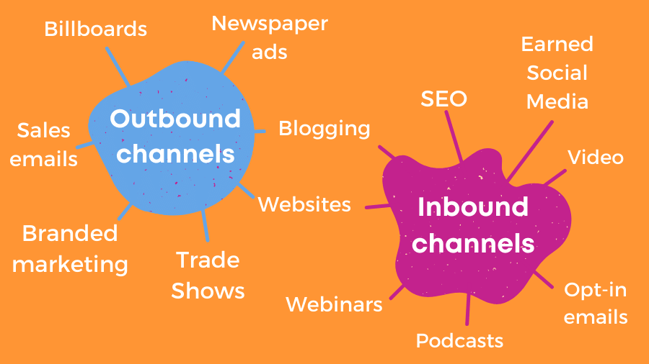So, you’ve decided you’re going to use inbound marketing to generate more leads for your business - fantastic! Now, what tools does that put at your disposal? And which ones should you be focusing on?
What are Inbound Marketing Channels?
By inbound marketing channels, we mean all the different ways you can attract potential customers to your website.
With an outbound marketing strategy, channels might mean things like the image and video ads you hope to run, the leaflets you’re planning to distribute and the telemarketing going out to your potential customers. As you might have noticed, all of these channels are something that disrupt the normal flow of your prospect’s life and really only go one-way.
With inbound, the focus is on drawing prospects towards your company through creating relevant, valuable content. However, that doesn’t just have to mean writing blog after blog (although they are fantastic for SEO).

Depending on how your target market behave online, it could mean sharing interesting images on social platforms, building relevant landing pages for resources on your website, or even expanding into video or audio mediums.
A post about channels would also be incomplete without mentioning SEO, since it’s really complementary to an inbound strategy, getting more eyes on the content you’ve spent all that time producing.
Blogs
Blogging is such a commonly recommended inbound channel that it almost seems a cliché to mention it… but they really do generate results.
The stats speak for themselves
- Businesses that blog get 55% more website visitors than businesses that don't
- Marketers that prioritise blogging in their content marketing see 13-times the ROI of businesses that don't
If you're hoping to use gated content to gain the contact information of your leads, your blog can also serve as an example as the kind of quality information you offer so that people can trust that what they’re downloading will be worth giving their email address for.
Blogs really work best when considered alongside other channels. Even if you’re written something perfect for your target market, they’re unlikely to ever see it if it only shows up on the eighth page of Google results.
Make sure you think beforehand about how each blog is going to be optimised for SEO, have a strategy in place for sharing new blogs across any social channels, and make sure high-converting blogs are displayed prominently on your website.
Talking of high-converting, make sure any blog posts you write have CTAs and paths to conversions within them – that’s one of the things that makes them inbound channels rather than simply an SEO tool. You want to guide people to the next logical step in the buying journey, whether that’s reading another post, downloading some content, watching a related video, or getting in touch.
Social Media
Social media is great for promoting your products or services, but it’s also a fantastic way to open two-way communication with your prospects. You can use the platform to find out what people are saying about your product or industry, engage your target market with questions, and connect on a more human level.
Microblogging platforms like Twitter and Tumblr are an opportunity to create bite-size micro content that can be shared further, spreading brand awareness. Photo and video-sharing platforms might be useful for showing the human side of your brand or adding some life to company announcements.
.png?width=662&name=channels%20(2).png)
If you’re a B2B business, you may not see the value in some social network platforms and you definitely don’t need an account on every single one of them. However, you might be surprised about the difference a little presence can make.
At the end of the day, businesses are still humans buying from other humans, so giving outsiders a peak at the personality of your business can help you to appear more trustworthy.
Just remember that it’s not all about broadcasting your message, you need to add value and contribute to the conversation. That’s how you turn tweets into visitors, and visitors into inbound leads.
Podcasts
As of 2021, there are 14.6 million podcast listeners in the UK, and the number is only predicted to rise.
Podcasts are brilliant for making the most of the knowledge and passion that already exists within your business. Members of your team with specialist knowledge can use a podcast to showcase their expertise to potential clients. It also gives your team the chance to display qualities such as openness, creativity, and integrity, which can make a prospect more likely to engage with your company.
Through inviting associates to take part in your podcast, it can also be an effective platform for networking and building business relationships.
At SpiderGroup, we’ve enjoyed putting our own spin on this channel by starting our SpiderCast- which mixes video with the conversational style of a podcast.
Just like blogs, you need to promote your content across multiple different channels to make sure it reaches an audience. The great thing about podcasts is that they bring in a whole new channel to the mix, and can be discovered on a variety of apps (like Spotify, Apple Podcasts, Stitcher, and others).
Email Marketing
Sending out emails might sound quite outbound but, when used with an inbound strategy, using email for marketing is an effective way to get relevant content in front of prospective customers.
Unlike social media, emails are a chance to have one-to-one conversations with prospects that can feel extremely personal.
On the later end of the sales process, or if you have a lot of resource on your hands, these emails really can be composed individually to suit the journey of individual buyers.
If you have a CRM such as HubSpot, another option is to segment your contacts and send emails only to those who meet certain criteria - such as a particular job role. This will help to make sure that the emails you send are relevant to the specific needs of the recipient, while also saving you the time it would take to craft individual messages.
Use emails to showcase the content you’ve been producing for other channels, invite people to find your podcast, or ask for insights and ideas.
Video
With TikTok continuing to explode in popularity, YouTube being the second-largest search engine after Google, and 59% of executives stating that they would rather watch video than read text, it’s obvious that this medium really has something to it.
It’s not difficult to see the appeal. Video can engage viewers through dynamic image and sound and often feels like it takes less effort to consume than written content.
When it comes to content creation, video can also be fairly straightforward to produce. This is especially true now that most smart phones contain a camera with an image quality that would make any 1980s director weep with happiness.
Like Podcasts, video can give the opportunity to show off the expertise you have in-house and help viewers feel like they know your team before they even have their first conversation. You can provide product demos that allow people to engage if they’re still considering their options and aren’t ready to get in touch just yet. You can showcase case studies and testimonials. You can do so much with video.
And don’t forget to make sure you’re sharing it (yes, that’s a real theme with inbound).
SEO
We’ve spoken in more depth about SEO in the past, so we won’t go into the whole thing again here, but it’s always worth mentioning, and well worth including in your marketing plan.
SEO tools such as SEMrush can help you to identify the gaps in the content already available online and what topics it would be useful to include within a wider area of expertise.
Once you’ve written your content, following SEO practices helps search engines to correctly identify when you’ve provided the most useful reply to a query.
Optimising for SEO often only requires a few tweaks in language and layout but it can make your content much more accessible to your target market.
What Inbound Marketing Channels Produce the best ROI?
This will really vary depending on your target audience, your business type, and how much resource you can currently invest. However, these statistics from recent HubSpot and Litmus reports might help to give you an idea.
- More than 1/3 of Litmus respondents ranked email as “the most effective” marketing channel in their organisation.
- 63% of podcast listeners made a purchase based on something the host recommended
- 73% of marketers say that social media marketing is effective for their business
- 75% feel that SEO tactics are ‘extremely’ or ‘very’ effective at helping them achieve their marketing goals
- 87% of video marketers reported that video gives them a positive ROI
- 83% of respondents are either ‘very’ or ‘somewhat’ confident that their website is helping them reach their marketing goals
How do I choose the right Inbound Marketing Channels?
Before you choose the channels you want to explore, it’s important to bring everything back to your target audience. Perhaps you’ve created specific personas – a semi-fictional notion of your ideal customer – or have a list of attributes many of your customers have in common.
With that target market (or markets) in mind, you can consider how they usually behave online - you could even survey existing customers. Think about what websites and platforms they might check regularly and what drives them to do this.
.png?width=533&name=channels%20(3).png)
Another useful question to explore is how they find answers to any questions they have – do they prefer reading blogs, watching YouTube videos, listening to a podcast or asking Alexa?
If you’re marketing towards other businesses, you might think about how their senior staff keep up with industry updates day-to-day.
Some channels – for example, a really effective website - are likely to be important whoever you are but, other than that, think about
- How you can get your business in front of the kind of people who will love your product
- How you can provide them with something they value once you’re there
As you settle into your inbound strategy, you will probably also be able to see from your analytics which channels are performing the best. With that information, you’ll be better placed to decide which existing platforms need to be amended or scrapped, and which additional ones are likely to work for you.
If you have an integrated marketing platform (like HubSpot), you can see which channels are not only bringing in leads, but also which ones are bringing in the type of lead that converts into customers. Attribution reporting can help you break down the return on investment for each of the different channels.
Then you ramp up the ones with the best ROI, optimise the ones with a positive ROI, and re-strategise or remove the ones that aren’t delivering.
Can I pick just one or two channels?
Depending on your time, resource, and budget, you might be able to cover a wide range of channels, or you might be limited to just a couple. The trick is to focus on finding your audience and continually monitor those channels to see if they are the best ones for you to be on.
Many of the channels work together, because sharing content across multiple platforms boosts its reach and effectiveness, so try to have a mix of different ways to generate value for your target audience.
If time is the issue, engaging with an agency or freelancer who can help you get more content out there is definitely a good strategy – the more (high quality) content you can produce, the sooner you’ll see results.

.png)

.png?width=533&name=Goal%20Setting%20(1).png)

